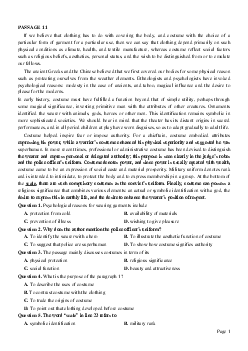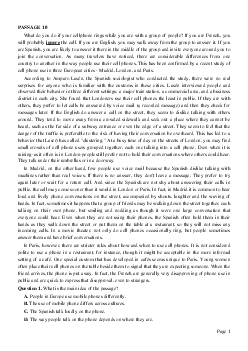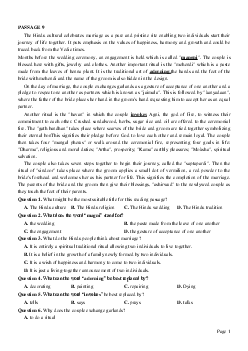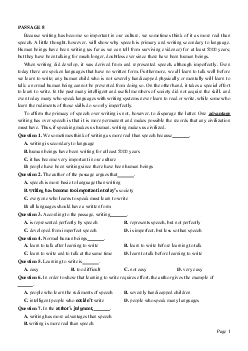

Preview text:
PASSAGE 9
HISTORY OF THE HELICOPTER
Although first flight generally attributed to a fixed-wing aircraft, the helicopter actually represents the
first style of flight envisioned by humans. The ancient Chinese developed a toy that rose upward when
spun rapidly. As early as the mid-sixteenth century, the great Italian inventor Leonardo da Vinci had
drawn a prototype for the machine that we now know as the helicopter.
Early in the twentieth century, a great deal of experimentation and revision was taking place with
regard to helicopter flight. The well-known phrase “two steps forward and one step back” provided an apt
descriptor for early flight development. Uneven lift, known as dissymmetry, caused the early helicopters
to flip over and confounded the inventors until the creation of the swash-plate; this allowed the rotor
blade angles to be changed so that lift would be equal on each side of the shaft.
On November 13, 1907, the French pioneer Paul Cornu made history by lifting a twin-rotor helicopter
into the air for a few seconds without ground assistance. Several models followed without significance
until in 1924 when another French pioneer, Etienne Oehmichen, became the first to fly a helicopter for
one kilometer. It was a historic flight of 7 minutes and 40 seconds. By 1936, solutions have been found to
many of the problems with helicopter flight.
With the introduction of the German Focke-Wulf Fw 61, the first practical helicopter became a reality.
Question 1. What is the topic of the passage?
A. Which aircraft was the first to fly.
B. Aircraft design in the 20th century.
C. The development of the helicopter.
D. The invention of the swash plate.
Question 2. Why was “dissymmetry” important to the early pioneers of helicopter flight?
A. It was an effect that caused helicopter to crash. B. It equalized lift on each side of the central shaft.
C. It allowed helicopters to lift from the ground. D. It allowed the rotor blade angles to be altered.
Question 3. Why was Paul Cornu’s flight important?
A. It was the first practical helicopter flight.
B. It lasted 7 minutes and 40 seconds.
C. It was the first time a helicopter lifted into the air without ground assistance.
D. It was the first time a helicopter lifted into the air.
Question 4. Why is it important that lift be equal on both sides of the helicopter shaft?
A. If there is more lift on one side, the helicopter will flip.
B. Equal lift means that the helicopter will be faster.
C. Dissymmetry of lift makes helicopters fly well.
D. It allows the rotor blade angles to be changed.
Question 5. The word “envisioned” in paragraph 1 is closet in meaning to . A. imagined B. perfected C. experienced D. taught
Question 6. The word “this” in paragraph 2 refers to . A. dissymmetry B. action C. swash-plate D. lift
Question 7. What is the tone of the passage?
A. An impartial overview of the development of helicopters. Page 1
B. A biased representation of the development of helicopter flight.
C. A personal account of helicopter development.
D. A comparison of helicopters and fixed wing aircraft. ĐÁP ÁN 1-C 2-A 3-C 4-B 5-A 6-C 7-A
LỜI GIẢI CHI TIẾT Question 1:
Chủ đề của đoạn văn nói về “the development of the helicopter”: sự phát triển của máy bay trực thăng Question 2:
Tại sao “tính không đối xứng” lại quan trọng với những chiếc máy bay trực thăng trước đây
Đáp án nằm ở dòng 3, 4 và 5 đoạn 2: “Uneven lift, known as dissymmetry, caused the early helicopters to
flip over and confounded the inventors until the creation of the swash-plate; this allowed the rotor blade
angles to be changed so that lift would be equal on each side of the shaft.” Question 3:
Đáp án nằm ở dòng 1 + 2 đoạn 3: “On November 13, 1907, the French pioneer Paul Cornu made history
by lifting a twin-rotor helicopter into the air for a few seconds without ground assistance” Question 4:
Đáp án nằm ở dòng 3, 4 và 5 đoạn 2: “Uneven lift, known as dissymmetry, caused the early helicopters to
flip over and confounded the inventors until the creation of the swash-plate; this allowed the rotor blade
angles to be changed so that lift would be equal on each side of the shaft.” Question 5:
Envisioned ≈ imagined: mường tượng, hình dung Question 6:
Swash-plate: tấm swash plate: là cái đĩa có thể tạo các góc so với trục của nó
Đáp án nằm ở dòng 3, 4 và 5 đoạn 2: “Uneven lift, known as dissymmetry, caused the early helicopters to
flip over and confounded the inventors until the creation of the swash-plate; this allowed the rotor blade
angles to be changed so that lift would be equal on each side of the shaft.” Question 7:
Đặc điểm chung của bài văn là “một khảo sát công bằng về sự phát triển của máy bay trực thăng Page 2




